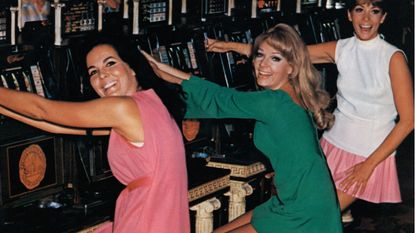The inflation scare is far from over, warns the Bank of England
The Bank of England's chief economist has warned that UK consumer price inflation will soon spike as the economy reopens, calling it a “tiger” that could prove “difficult to tame”

Is inflation a “tiger” or a “pussycat”? asks Gurpreet Narwan in The Times. Andy Haldane, the chief economist at the Bank of England, has warned that UK consumer price inflation will soon spike from its current level of 0.7% as the economy reopens. Haldane likened inflation to a “tiger” that has been “stirred by the extraordinary events… of the past 12 months”. It could prove “difficult to tame”. Not all of his colleagues agree. Deputy governor Dave Ramsden notes that UK inflation expectations (as measured by surveys) remain “well anchored” for now.
Bond markets totter
Concern about a more inflationary outlook rocked global bond markets last week. As bond prices fell, the US ten-year Treasury bond yield spiked towards 1.6%, a significant rise from the 0.9% level at which it started the year. The surge in yields hit stocks: higher bond yields prompt investors to sell shares and buy bonds. America’s tech-focused Nasdaq index plunged by 3.5% last Thursday, its worst one-day performance since October. The following day the FTSE 100 dropped by 2.5%.
The FTSE bounced back 1.3% on Monday, generating “a huge sigh of relief”, says Russ Mould of AJ Bell. Progress on Joe Biden’s $1.9trn stimulus bill (see page 10) soothed markets. Bond yields settled, with the US ten-year trading around 1.4%, calming fears that last week’s yield tantrum could precipitate an even larger rout.
Subscribe to MoneyWeek
Subscribe to MoneyWeek today and get your first six magazine issues absolutely FREE

Sign up to Money Morning
Don't miss the latest investment and personal finances news, market analysis, plus money-saving tips with our free twice-daily newsletter
Don't miss the latest investment and personal finances news, market analysis, plus money-saving tips with our free twice-daily newsletter
The bond yield spike shows that markets disagree with the US Federal Reserve about the economic outlook, says Eoin Treacy for fullertreacymoney.com. Fed chair Jerome Powell insists that the recovery is shaky, pointing to high US unemployment. That means interest rates will need to stay low for a long time. Investors, by contrast, increasingly think we are heading for a swift reflationary recovery. That would drive inflation higher and force the Fed to hike interest rates sooner rather than later.
Swinging back to the sixties
Expect more “turbulence”, says the Financial Times. Investors have grown so accustomed to ultra-low interest rates and quiescent inflation that even a modest shift to a “higher-rate, higher-inflation regime” could unleash “cascades of repricing” and “swingeing losses” for portfolios. “In truth, this is a good news story”; markets are anticipating a robust recovery and higher but not uncontrollable inflation. Inflation doves point out that massive quantitative easing (QE) after the financial crisis did not bring higher inflation, say Michael Bordo and Mickey Levy in The Wall Street Journal. But where that cash ended up as “excess reserves that sloshed around” the banking system, this time stimulus is far bigger and more direct – state cheques have been paid straight to US households.
“There is a long history of high budget deficits” heralding inflation; inflation began to tick up in the mid-1960s but governments on both sides of the Atlantic kept on spending, which led to crippling stagflation that blighted Western economies until the 1980s. It can be a surprisingly “short march” from low inflation back to high inflation.
-
 British Airways revamps Avios scheme bringing down flight prices to £1
British Airways revamps Avios scheme bringing down flight prices to £1With the new Avios part-payments scheme you can now bag a British Airways flight for as little as £1
By Oojal Dhanjal Published
-
 RBS to close a fifth of branches
RBS to close a fifth of branchesRoyal Bank of Scotland plans to shut 18 branches across Scotland, resulting in the loss of 105 jobs. We have the full list of closures.
By Ruth Emery Published
-
 Should your business invest in a VoIP phone service?
Should your business invest in a VoIP phone service?Here's what you need to know about VOIP (voice over IP) services before landlines go digital in 2025.
By David Prosser Published
-
 The end of China’s boom
The end of China’s boomLike the US, China too got fat on fake money. Now, China's doom is not far away.
By Bill Bonner Published
-
 What is the future of Royal Mail in the UK?
What is the future of Royal Mail in the UK?With fewer of us sending letters and parcels, the Royal Mail is finding dealing with the nation’s post is an increasingly unprofitable and costly business.
By Simon Wilson Published
-
 What's the secret of Manolo Blahnik's success?
What's the secret of Manolo Blahnik's success?Fashion maestro Manolo Blahnik shows little sign of slowing down at 81, and his company notched up a record financial year in 2022. What is the secret of his success?
By Jane Lewis Published
-
 Michelle Mone's "tough year of pain"
Michelle Mone's "tough year of pain"Michelle Mone liked to portray herself as a working-class heroine who worked her way to the top through grit and determination. But her pedestal is built on sand.
By Jane Lewis Published
-
 Trevor Milton, the Elon Musk wannabe, is jailed for fraud
Trevor Milton, the Elon Musk wannabe, is jailed for fraudThe former CEO of Nikola, Trevor Milton, has been found guilty of lying about the development of the company's electric trucks.
By Jane Lewis Published
-
 Directors should think twice before waiving limited liability
Directors should think twice before waiving limited liabilityShould small-business directors ever provide a personal guarantee in return for bank finance?
By David Prosser Published
-
 Why Russia's economy is doing better than predicted
Why Russia's economy is doing better than predictedSanctions were supposed to strangle Russia’s economy, but it seems to be thriving. What’s going on?
By Simon Wilson Published